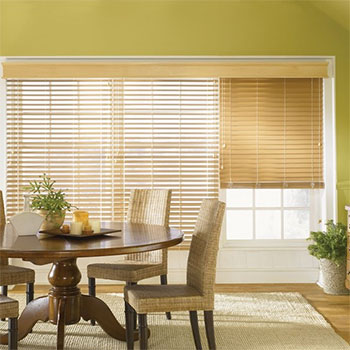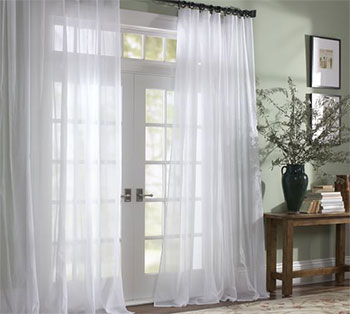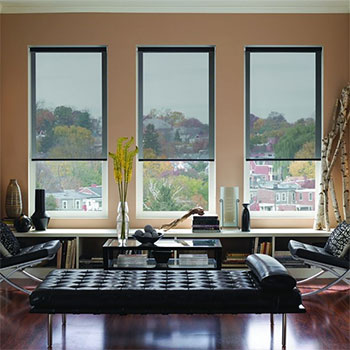How to Select the Perfect Window Treatments
by Rachel Lyon, Editorial Director for The House Designers®
Are your windows a bit lacking? Windows themselves can be made more beautiful and architecturally correct for your home by exploring different hardware and finish options, but don’t let it end there. Carefully selected treatments can improve the look of a house both inside and out, and of course you’ll also love the practical benefits that they offer, like increased privacy, natural light control, and even energy efficiency. Here are some tips to help you make the best window treatment decisions for your home!
The
Bali Faux Wood Blind – 2” from
Blinds.com offers a stylish solution that adapts to needs as sun exposure changes throughout the day and seasons. The wood-look slats are made of highly durable PVC to minimize maintenance.
The Basic Types
Dressing windows is a bit more complicated than most people think, because the terms used to describe various treatments are often used interchangeably. If you know the right vocabulary, you’ll have an easier time deciding what you really want and need, and communicating that when it comes time to shop.
Blinds – Consist of hard slats hung horizontally or vertically, which can be lowered or pulled to block the window. The angle of the slats can be adjusted to open and close the view of the window.
Shades – Made of soft materials that can be moved to partially or fully cover a window. While you can find shades with very different levels of opacity, they are not adjustable like blinds.
Curtains – Composed of lightweight, unlined fabric for a casual dressing. Can be any length necessary to cover the window.
Drapes – Usually lined and made with heavy fabric that is good for blocking light and insulating. Drapes are more formal than curtains, often pleated, and hang to the floor.
The basic function of these treatments is what determines their type, and you will find that they can look vastly different within the same category. It goes far beyond colors and patterns on fabric—materials and modes of operation are so diverse that you’ll have plenty to consider. For example, shades can be made of fabric, wood or bamboo, or even take on a cellular construction that helps insulate windows, and they can be rolled down with cords, pushed up and down window frames with just your hands, slid into place like a shoji door, or controlled from across the room with a remote and motorized system. You definitely need to see all the options before making decisions.
The
Classic Voile Sheer Drape from
Pottery Barn is a light and airy dressing that helps beautifully diffuse light as it enters the home. Despite its name and length, it definitely functions like a curtain.
Choosing Function and Fashion
Deciding what to use in your own home is difficult with all the choices out there, but that only gives you a better chance of finding absolutely perfect window treatments for your style. Most people are primarily concerned with looks, but you should also consider how different dressings can affect your comfort and the livability inside your home. Think about your relationship with windows—if you’re not a morning person and early sunlight is a problem, invest in treatments that will help keep your bedroom dark, but if you love natural light, filtering shades or curtains can help brighten your interior while taking the edge off the sun’s glare.
Blinds are chosen for their utility first and foremost, even if they come in many attractive designs. The ability to control not only how much of the window is covered but also the degree to which it is, makes blinds the go-to choice for homes and professional buildings alike. Shades also offer a huge range of possibilities, but because they are not adjustable, they are better selected once you know exactly what you need for any given space. For instance, you might opt for heavier shades on south-facing windows and lighter ones on the north side of the house due to different levels of sun exposure.
On the other hand, when people shop for curtains and drapes, fashion is usually first in their minds. These come with a variety of hanging options, and they can even be used to change perception of spaces. You can install a hanging rod well above the window frame to visually raise the height of your ceilings, and the hardware you choose imparts a distinct ambiance in each setting. Whether you want light and breezy curtains that give a room personality or heavy drapes to complement a formal dining room, these options are made to appeal to your aesthetic needs. And if you really want to go all out, you can coordinate colors and patterns on the exterior-facing side to give your home a little extra curb appeal when the window treatments are partially or fully closed.
These
Signature Solar Roller Shades from
Blinds.com help filter the sun without impeding the view outside. Choose from dozens of options to find the best color, pattern, and material for your home.
Layering Window Treatments
Depending on your location and the conditions surrounding your home, you might like to use dressings in tandem to reap the best of both. Blinds and shades are installed inside the interior window casing while curtains and drapes are usually hung from the outside, on the trim or the wall above, so it’s not difficult. When the blinds and shades are drawn up and out of the way, you probably won’t even notice them, but they’ll be there when you need them. You can also layer sheer curtains with heavy drapes so long as they are installed with the right kind of hardware.
The layered approach gives you the chance to customize your window treatments to your exact requirements. There are many people who want to completely block harsh sun but don’t like the dreary look that blackout drapes can sometimes cast; in this case, blackout shades can perform their duty when necessary and then disappear from sight to let gentler natural light filter through the curtains. And if you live in an extreme climate, your choice of window treatments can do a lot for you—solar shades block UV rays to keep your interior comfortable and prevent issues like furniture fading while still letting you see the outdoors, and pairing cellular shades with heavy drapes will do amazing things for your utility bills when the weather threatens your home’s efficiency. So don’t be afraid to mix and match, because you will probably love the solution you come up with no matter your situation!
Before you go out to explore the possibilities, be sure to measure every window you want to dress. Write down each width and height on the inside of the frame for blinds and shades, as well as outside the trim for curtains and drapes. If you want to hang them high to seemingly raise your ceiling, you’ll need to measure that height, too. This is the most important part of buying window treatments yet it is often forgotten, so make it easier on yourself by preparing ahead of time.



.png)
.png)




